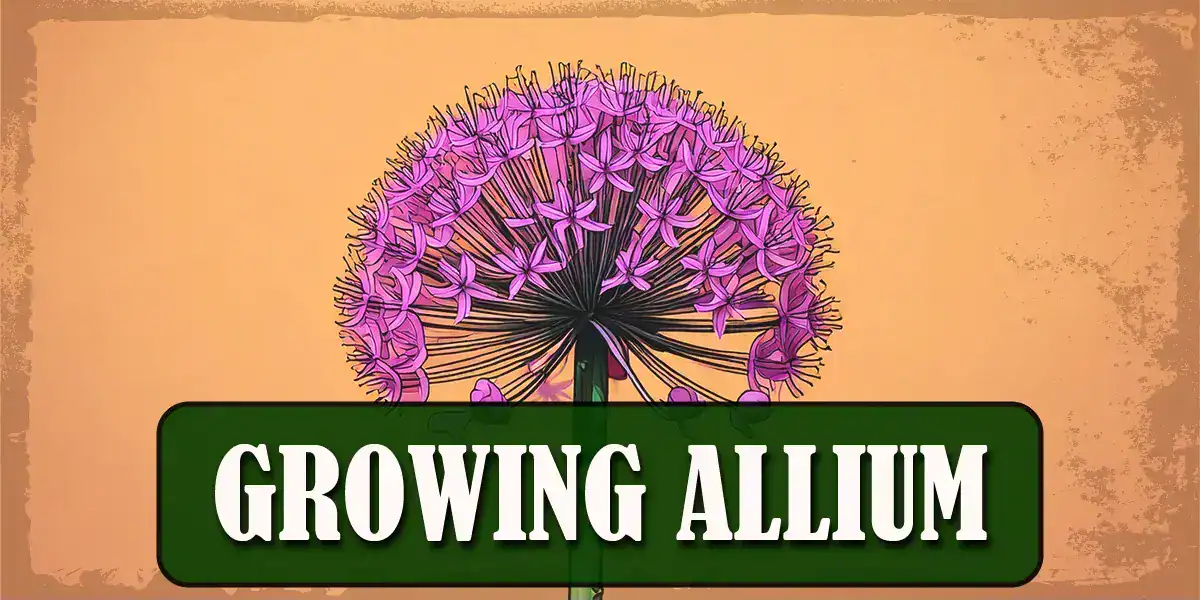Have you ever seen those striking purple spheres towering over garden beds in late spring?
They’re so whimsical, they almost look like something from a Dr. Seuss story.
Those are alliums — pollinator-friendly, deer-resistant ornamentals that add height and drama to a flower garden.
They’re surprisingly easy to grow. The catch: SoCal’s mild winters mean your bulbs may need a little extra help to thrive. But with one simple trick (which involves your fridge), you can enjoy globe-shaped blooms that pollinators love and pests avoid.
What Are Alliums?
Alliums belong to the Amaryllidaceae family, a group comprising over 900 species that includes both edible types (such as onions, garlic, and leeks) and stunning ornamentals. The name comes from the Latin word for “garlic,” a reference to their sulfur-rich scent.
Ornamental alliums produce globe-shaped clusters of tiny flowers atop tall, sturdy stems. They bloom in late spring and early summer, adding height and texture to borders, cottage gardens, and pollinator-friendly landscapes.
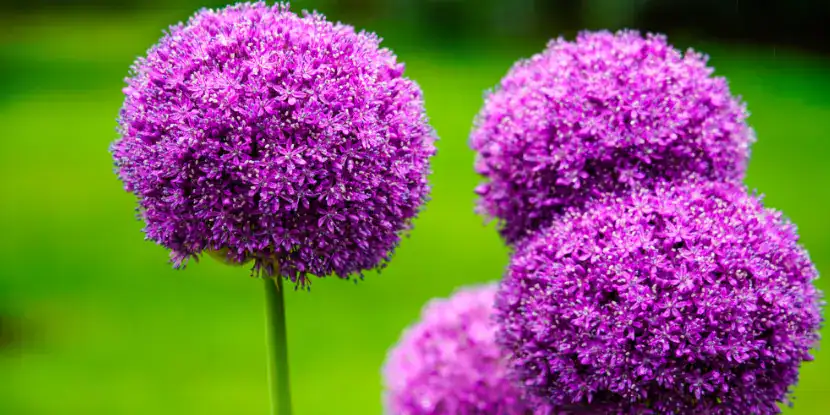
Allium blossoms with their Seuss-like purple heads.
Why Alliums Can Thrive in Southern California
Alliums naturally come from regions with cool winters and dry summers, similar to Southern California’s Mediterranean climate.
Varieties like Allium giganteum, Allium aflatunense, and Allium schubertii adapt well to our conditions as long as you:
- Plant them at the right time
- Provide well-drained soil
- Give them a cold period before planting
The only challenge is that SoCal winters don’t always provide enough chilling time for the bulbs. Luckily, that’s easy to fix.

Allium Purple Sensation flowers are truly, well, sensational.
Pre-Chilling Is the Secret
Alliums need a period of cold dormancy to trigger root and flower development. In colder climates, this happens naturally underground. In SoCal, you’ll need to replicate it.
How to Pre-chill Bulbs
- Place bulbs in a paper bag (not plastic).
- Store them in your refrigerator for 6–8 weeks.
- Keep them away from fruits like apples or bananas, which release ethylene gas that can damage bulbs.
Timeline
- Start chilling: Late September or early October
- Plant outdoors: November or December, once nighttime temps stay below 55°F
This simple step makes all the difference between weak stems and showy blooms.

The weirdly beautiful Allium schubertii blossom.
Best Allium Varieties for Southern California
Varieties that perform best in heat include:
- Allium aflatunense ‘Purple Sensation’ — Deep purple globes; excellent for borders
- Allium giganteum — Tall, dramatic mid-spring bloomer
- Allium schubertii — Firework-like shape; very ornamental
- Allium cristophii (Star of Persia) — Silvery-violet blooms; drought-tolerant
- Allium sphaerocephalon (Drumstick Allium) — Late-blooming and heat-loving
All these perennial bulbs return year after year with minimal care.
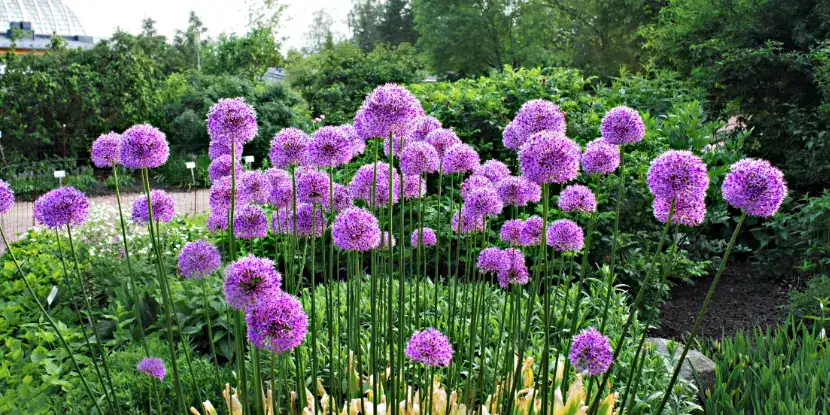
It should be obvious how Allium giganteum got its name.
Growing Conditions for SoCal
Light
Alliums need at least 6 hours of direct sunlight daily. In hot inland valleys, some afternoon shade helps prevent stress.
Temperature
Alliums prefer cool spring temperatures. Coastal areas provide ideal conditions. Inland gardeners should plant bulbs in areas that receive morning sun and light afternoon shade.

Allium cristophii is exceptionally drought-tolerant.
Soil
Well-drained soil is non-negotiable. Alliums rot in soggy conditions.
- Best soil types: Sandy or loamy
- pH: Neutral to slightly alkaline
- Amend heavy clay with compost or grit to improve drainage.
- Add light mulch to moderate soil temperature and reduce weeds.
Bulbs vs Seeds
Bulbs yield quick blooms; seeds suit patient gardeners experimenting with hybrids.
How & When to Plant Allium Bulbs
When to Plant
- Fall, about 4–6 weeks before the first frost (November–December in most of SoCal)
- After you’ve pre-chilled bulbs for 6–8 weeks
Planting Depth
- Plant 2–3 times deeper than the bulb’s height
- Always place the pointed end up
Spacing
- Space bulbs 6–8 inches apart
After planting
- Water well to settle soil around bulbs
- Avoid soggy conditions throughout winter
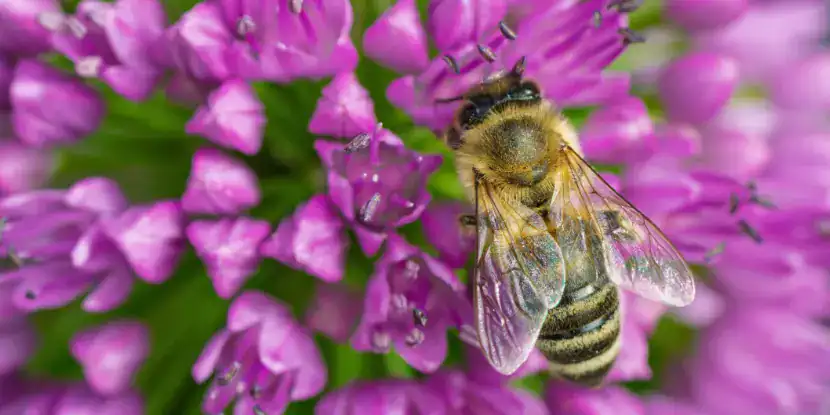
Bees and other pollinators are drawn to the allium bloom.
Allium Plant Care
Watering
- Water lightly after planting
- Rely on winter rains for moisture
- Once established, alliums are drought-tolerant
- Water only when the top 2 inches of soil dries
Fertilizer
- Apply balanced bulb fertilizer in early spring as shoots emerge
- Avoid over-fertilizing, which can weaken stems
Pests & Diseases
Alliums are naturally pest-resistant.
- Deer and rabbits avoid them due to their strong scent
- Sulfur compounds repel rodents
- Well-drained soil prevents rot and fungal issues
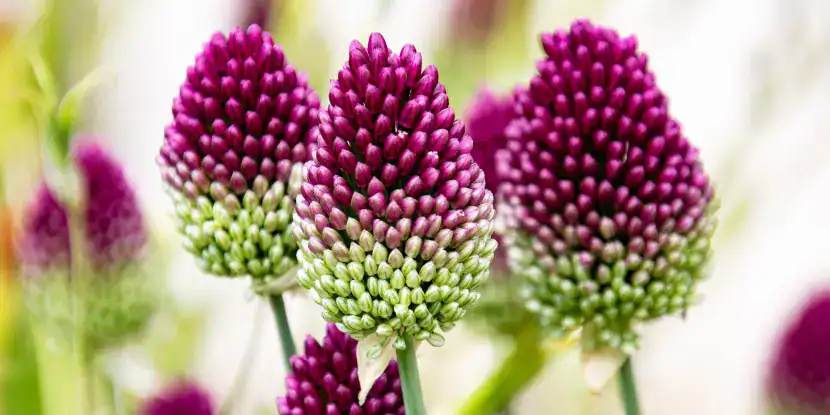
Allium sphaerocephaion buds on their tall spikes.
Propagating Alliums
Propagation by Bulb Division (Offsets)
Every few years, mature bulbs produce smaller bulbs called offsets.
- Dig up clumps after foliage dies back in summer
- Gently separate offsets
- Replant immediately or store in a cool, dry place until fall
Propagation by Seeds
- Collect seeds from dried flower heads
- Sow in the fall or early spring
- Germination can take weeks to months
- Plants bloom in 2–5 years
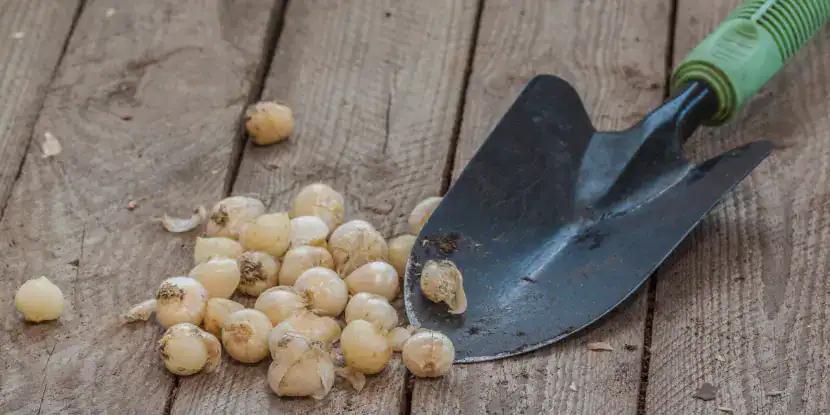
Allium bulbs ready for planting. The should be chilled for 6 to 8 weeks prior.
Natural Self-Propagation
Some varieties (like Allium sphaerocephalon) self-seed readily. Let spent flower heads dry on the stem to encourage natural spreading.
After Bloom Care
- Allow foliage to die back naturally — it feeds the bulb for next year
- Stop watering once leaves yellow completely
- In very hot, dry summers, consider lifting bulbs and storing them in a cool, dry place until fall
Bonus Tip: Complement with California Natives
Alliums pair beautifully with drought-tolerant natives like:
- Salvia
- Penstemon
- California poppies
- Buckwheat
Their upright blooms contrast perfectly with low-growing perennials for a striking, water-wise design.

White and purple alliums in a field of flowers.
FAQs: Growing Alliums
Q: Are alliums annuals or perennials?
Most ornamental alliums are perennials. They return year after year with minimal care. Some smaller varieties may self-seed and spread naturally through the garden.
Q: How long do allium blooms last?
Blooms typically last 2 to 4 weeks. The dried seed heads remain attractive for months and make excellent cut flowers.
Q: Can I grow alliums in pots?
Yes. Use a deep container (at least 12 inches in diameter) with drainage holes. Choose shorter varieties like Allium sphaerocephalon for the best results.
Q: Do alliums attract pollinators?
Absolutely. Bees, butterflies, and hoverflies love their nectar-rich flowers.
Q: When do alliums bloom in Southern California?
Typically, late spring to early summer, from April to June, depending on the variety and location.
Q: Can I plant alliums with other bulbs?
Yes. They pair well with tulips, daffodils, and irises. Their tall stems add vertical interest to mixed bulb plantings.
Q: What if my alliums don’t bloom?
Common causes include insufficient chilling, planting too shallow, poor drainage, or lack of sunlight. Ensure bulbs get 6–8 weeks of cold and full sun exposure.
Q: Are alliums toxic to pets?
Yes. Like onions and garlic, ornamental alliums contain compounds toxic to dogs and cats. Plant them in areas pets can’t access.

